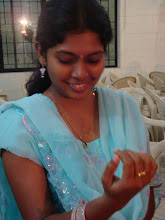Before I jump on into the recipe-ing spree, I would like to put a word on my style/preferences of cooking/eating..
I prefer Indian and Oriental Cuisine, for the simple reason that the aroma of the spices and flavors of these dishes leads me to Nirvana.
But that doesn't mean I would love spicy hot crispy chilly vegetables or it version of the curry.
Now, that brings me to the point where I need to mention the Ingredients I Don't (prefer) Use:
- Onions (qn: how could u ever start the cooking as such without onions? ans: well.. well.. don't worry.. i cook dishes sans onions which tastes much better than those with onions)
- Garlic (now i can hear u screaming SOS )
- Green Chillies
- Asafoetida
- Brinjal
The above mentioned ingredients are basically Negative Pranic. Prana, in short, is Life Energy. For those who practice Yoga, including me, would observe a stark difference on consuming food cooked with any of these negative pranic foods.
For those who are convinced on why we don't use the above mentioned ingredients, please skip the following lecture. :D
For the Others, Good Morning,
--Lecture Starts--
Some may argue that Onions purify blood, Garlic reduces cholesterol etc. Yes. It does. I don't deny that. Peace.
All plants existing on the planet is medicinal and curative in one or more ways. So, can we eat all the plants that our eyes could set and hands could lay upon?
The venom of King Cobra is used in the treatment of Paralysis. But, only 1 in 1000 parts of the venom is taken and used in the medicines.
So, now that i have offered some gyaan (do you sense an aura around me ;) , I just meant to say that ingredient used for food or medicine should be taken in the right proportions and form. Doesn't that make more sense?
--Lecture Ends--
Also, Coffee and Tea are Negative Pranic . Because they are Nervous Stimulants. Beverages like Pepsi, Coke, Fanta and its family of products are also nervous stimulants. Since these aren't ingredients, but consumed as a whole, I did not mention it earlier.
So, if some foods are negative pranic, some should be positive pranic (logically speaking) and some zero pranic.
Tubers like potato,colocasia,etc. and Tomato would come under Zero Pranic.
All other vegetables, fruits and nuts come under Positive Pranic Foods. The vegetable with the highest quotient of Positive Prana is Ash Gourd.
So, it is just a fraction of the Edible Ingredients that comes under Negative Pranic :) The rest could be eaten with delight !
It is good to have an understanding on what goes into our mouth.. Isn't it..?



